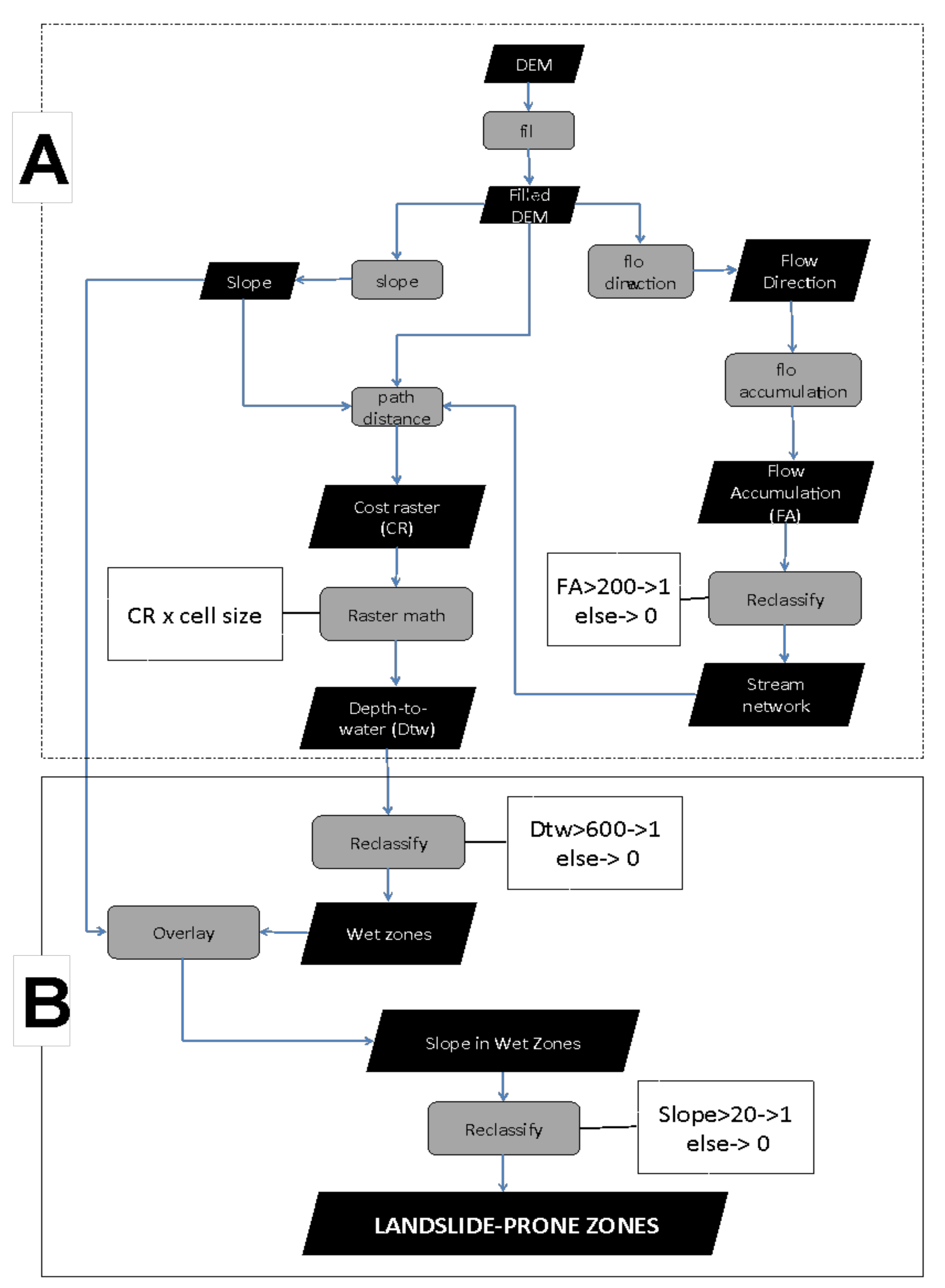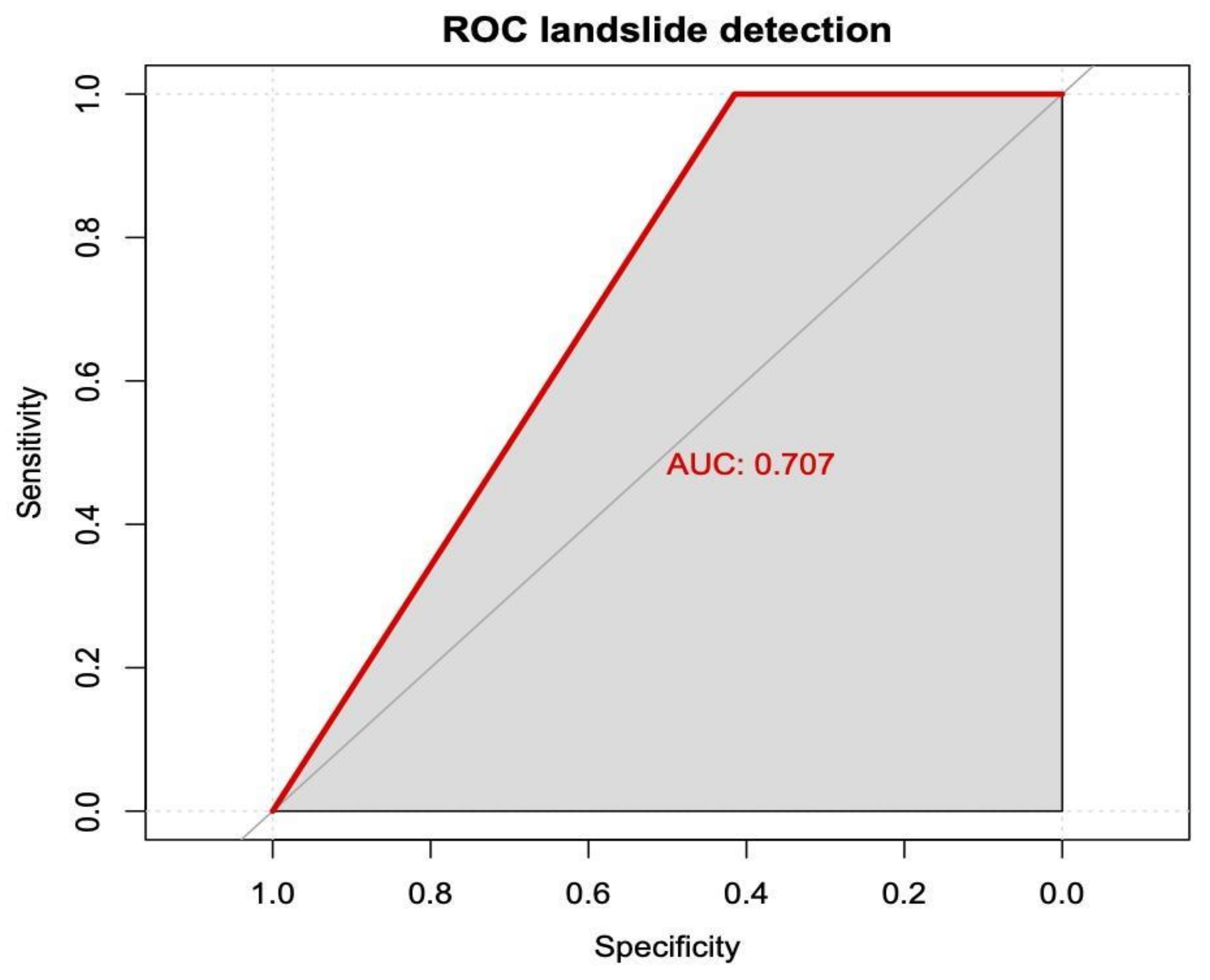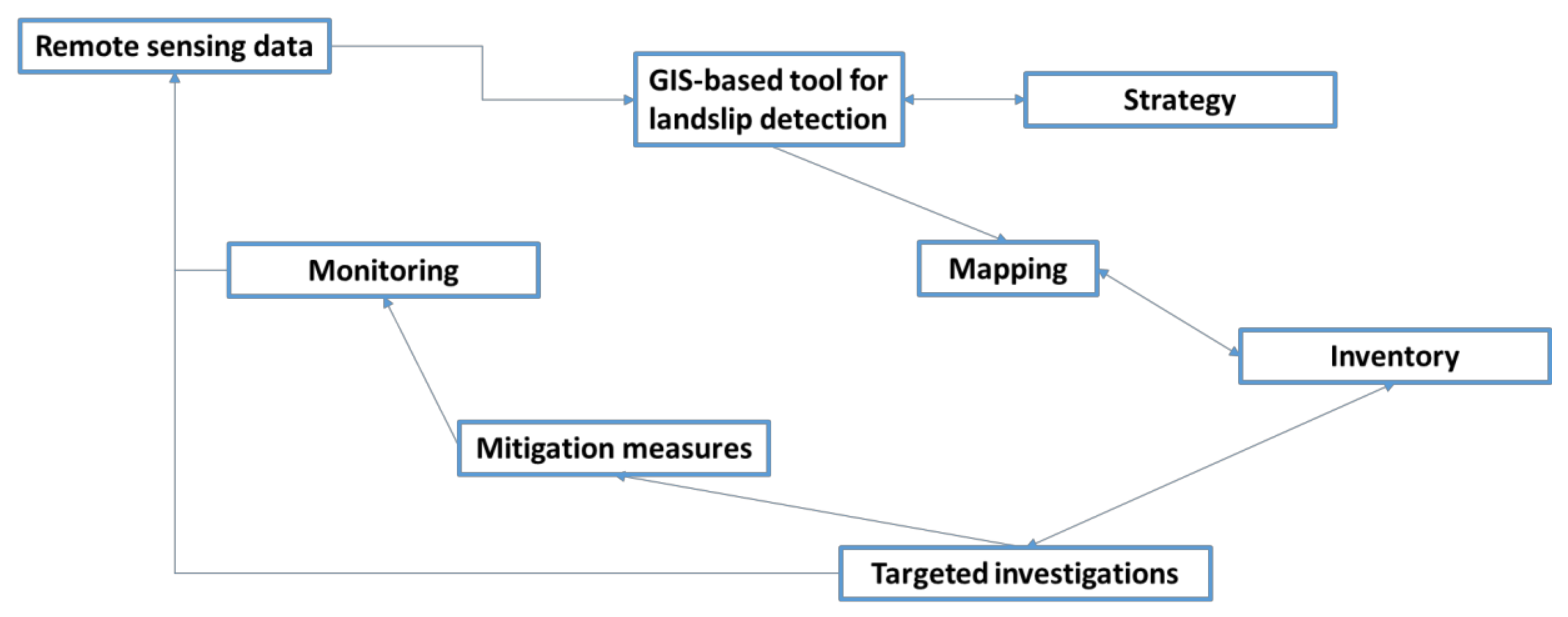A Simple GIS-Based Tool for the Detection of Landslide-Prone Zones on a Coastal Slope in Scotland
Abstract
:1. Introduction
2. Materials and Methods
2.1. Assumptions
2.2. Detection of Water Accumulation Zones
2.3. Detection of Landslide-Prone Zones
2.4. Tool Verification
3. Results and Discussion
4. Conclusions
Author Contributions
Funding
Institutional Review Board Statement
Informed Consent Statement
Data Availability Statement
Conflicts of Interest
References
- European Environmental Agency (EEA). Soil Erosion; Permalink:M2MK6NE2MP; EEA: Brussels, Belgium, 2012. [Google Scholar]
- Koutsoyiannis, D. Revisiting the global hydrological cycle: Is it intensifying? Hydrol. Earth Syst. Sci. 2020, 24, 3899–3932. [Google Scholar] [CrossRef]
- Lu, N.; Godt, J.; Or, D. Hillslope Hydrology and Stability; Cambridge University Press: New York, NY, USA, 2013. [Google Scholar]
- Varnes, D.J. Slope movement types and processes. In Landslides, Analysis and Control, Special Report 176: Transportation Research Board; Schuster, R.L., Krizek, R.J., Eds.; National Academy of Sciences: Washington, DC, USA, 1978; pp. 11–33. [Google Scholar]
- Sidle, R.C.; Bogaard, T.A. Dynamic earth system and ecological controls of rainfall-initiated landslides. Earth. Sci. Rev. 2016, 159, 275–291. [Google Scholar] [CrossRef]
- Mohan, A.; Singh, A.K.; Kumar, B.; Dwivedi, R. Review on remote sensing methods for landslide detection using machine and deep learning. Trans. Emerg. Telecommun. Technol. 2020, e3998. [Google Scholar] [CrossRef]
- Vanapalli, S.K.; Fredlund, D.G.; Pufahl, D.E.; Clifton, A.W. Model for the prediction ofshear strength with respect to soil suction. Can. Geotech. J. 1996, 33, 379–392. [Google Scholar] [CrossRef]
- Gonzalez-Ollauri, A.; Mickovski, S.B. Plant-Best: A novel plant selection tool for slope protection. Ecol. Eng. 2017, 106, 154–173. [Google Scholar] [CrossRef] [Green Version]
- Gonzalez-Ollauri, A.; Mickovski, S.B. Shallow landslides as drivers for slope ecosystem evolution and biophysical diversity. Landslides 2017, 14, 1699–1714. [Google Scholar] [CrossRef] [Green Version]
- Gariano, S.; Brunetti, M.; Iovine, G.; Melillo, M.; Peruccacci, S.; Terranova, O.; Vennari, C.; Guzzetti, F. Calibration and validation of rainfall thresholds for shallow landslide forecasting in Sicily, southern Italy. Geomorphology 2015, 228, 653–665. [Google Scholar] [CrossRef]
- Chae, B.-G.; Park, H.-J.; Catani, F.; Simoni, A.; Berti, M. Landslide prediction, monitoring and early warning: A concise review of state-of-the-art. Geosci. J. 2017, 21, 1033–1070. [Google Scholar] [CrossRef]
- Zhao, C.; Lu, Z. Remote sensing of landslides—A Review. Remote. Sens. 2018, 10, 279. [Google Scholar] [CrossRef] [Green Version]
- Ray, R.L.; Lazzari, M.; Olutimehin, T. Remote Sensing Approaches and Related Techniques to Map and Study Landslides. Landslides Investig. Monit. 2020. [Google Scholar] [CrossRef]
- Mondini, A.C.; Guzzetti, F.; Chang, K.-T.; Monserrat, O.; Martha, T.R.; Manconi, A. Landslide failures detection and mapping using Synthetic Aperture Radar: Past, present and future. Earth-Sci. Rev. 2021, 216, 103574. [Google Scholar] [CrossRef]
- Vorpahl, P.; Elsenbeer, H.; Maerker, M.; Schröder, B. How can statistical models help to determine driving factors of landslides? Ecol. Model. 2012, 239, 27–39. [Google Scholar] [CrossRef]
- Bui, D.T.; Hoang, N.D.; Nguyen, H.; Tran, X.L. Spatial Prediction of Shallow Landslide Using Bat Algorithm Optimized Machine Learning Approach: A Case Study in Lang Son Province, Vietnam. Adv. Eng. Inform. 2019, 42, 100978. [Google Scholar]
- White, B.; Ogilvie, J.; Campbell, D.M.H.; Hiltz, D.; Gauthier, B.; Chisholm, H.K.H.; Wen, H.K.; Murphy, N.C.; Arp, P.A. Using the cartographic depth-to-water index to locate small streams and associated wet areas across landscapes. Can. Water Resour. J. 2012, 37, 333–347. [Google Scholar] [CrossRef]
- Norris, J.E.; Stokes, A.; Mickovski, S.B.; Cammeraat, E.; van Beek, R.; Nicoll, B.C.; Achim, A. Slope Stability and Erosion Control: Ecotechnological Solutions; Springer: Berlin/Heidelberg, Germany, 2008; 290p. [Google Scholar]
- Gonzalez-Ollauri, A.; Mickovski, S.B. Using the root spread information of pioneer plants to quantify their mitigation potential against shallow landslides and erosion in temperate humid climates. Ecol. Eng. 2016, 95, 302–315. [Google Scholar] [CrossRef] [Green Version]
- Lee, E.M.; Brunsden, D. Sediment budget analysis for coastal management, west Dorset. Geol. Soc. Lond. Eng. Geol. Spéc. Publ. 2001, 18, 181–187. [Google Scholar] [CrossRef]
- Jones, D.K.C.; Lee, E.M. Landsliding in Great Britain; HMSO: London, UK, 1994; 361p. [Google Scholar]
- Eastman, J.R.; Fulk, M.; Toledano, J.; Hutchinson, C.F. The GIS Handbook; USAID: Washington, DC, USA, 1993. [Google Scholar]
- Zhu, X. GIS for Environmental Applications: A Practical Approach; Routledge: New York, NY, USA, 2016. [Google Scholar]
- ESRI. ArcGIS Desktop: Release 10.5. Redlands; Environmental Systems Research Institute: Redlands, CA, USA, 2016. [Google Scholar]
- Vieux, B.E. Distributed Hydrologic Modeling Using GIS; Springer Nature: Berlin/Heidelberg, Germany, 2016. [Google Scholar]
- GetMapping. GetMapping 2m Resolution Digital Surface Model (DSM) for Scotland and Wales; NERC Earth Observation Data Centre: Leicester, UK, 2014; Available online: http://cataloque.ceda.uk/uuid/4b0ed418e30819e4448dc89a27dc8388 (accessed on 21 April 2021).
- Chung, C.-J.F.; Fabbri, A.G. Validation of spatial prediction models for landslide hazard mapping. Nat. Hazards 2003, 30, 451–472. [Google Scholar] [CrossRef]
- Robin, X.A.; Turck, N.; Hainard, A.; Tiberti, N.; Lisacek, F.; Sanchez, J.-C.; Muller, M.J. pROC: An open-source package for R and S+ to analyze and compare ROC curves. BMC Bioinform. 2011, 12, 77. [Google Scholar] [CrossRef]
- Gonzalez-Ollauri, A.; Thomson, C.S.; Mickovski, S.B. Waste to Land (W2L): A novel tool to show and predict the spatial effect of applying biosolids on the environment. Agric. Syst. 2020, 185, 102934. [Google Scholar] [CrossRef]
- Apple Maps; Apple, Inc: Cupertino, CA, USA.
- Mickovski, S.B.; Santos, O.; Ingunza, P.M.D.; Bressani, L. Coastal slope instability in contrasting geo-environmental conditions. In Geotechnical Engineering for Infrastructure and Development—Proc. XVI European Conference for Soil Mechanics and Geotechnical Engineering, Edinburgh, Scotland, September 2015; Institute of Civil Engineers: London, UK; pp. 1801–1806.
- BGS (British Geological Survey). 1:50000 Geology [SHAPE Geospatial Data], Scale 1:50000, Tiles: sc067, Updated: 1 October 2013; BGS (British Geological Survey): London, UK, 2013. [Google Scholar]
- BS 1377. Methods of Test for Soils for Civil. Engineering Purposes, Parts 1–9; British Standards Institution: London, UK, 1990.
- BS EN 14688. Geotechnical Investigation and Testing—Identification and Classification of Soil, Parts 1–2; British Standards Institution: London, UK, 2004.
- Macdonald, A.M.; Ball, D.F.; Dochartaigh, B.É.Ó. A GIS of Aquifer Productivity in Scotland: Explanatory Notes; CR/04/047N; British Geological Survey Commissioned Report; BGI: London, UK, 2004; 21p. [Google Scholar]
- SNIFFER. Development of a Groundwater Vulnerability Screening Methodology for the Water Framework Directive; Final Report, Project WFD28; SNIFFER: Edinburgh, UK, 2004. [Google Scholar]
- Walker, L.R.; Velázquez, E.; Shiels, A.B. Applying lessons from ecological succession to the restoration of landslides. Plant. Soil 2009, 324, 157–168. [Google Scholar] [CrossRef]
- Zou, K.H.; O’Malley, A.J.; Mauri, L. Receiver-Operating Characteristic Analysis for Evaluating Diagnostic Tests and Predictive Models. Circulation 2007, 115, 654–657. [Google Scholar] [CrossRef] [Green Version]
- Jackson, B.M.; Wheater, H.S.; McIntyre, N.R.; Chell, J.; Francis, O.J.; Frogbrook, Z.; Marshall, M.; Reynolds, B.; Solloway, I. The impact of upland land management on flooding: Insights from a multiscale experimental and modelling programme. J. Flood Risk Manag. 2008, 1, 71–80. [Google Scholar] [CrossRef]
- Gonzalez-Ollauri, A.; Mickovski, S.B. Hydrological effect of vegetation against rainfall-induced shallow landslides. J. Hydrol. 2017, 549, 374–387. [Google Scholar] [CrossRef] [Green Version]
- Gonzalez-Ollauri, A.; Stokes, A.; Mickovski, S.B. A novel framework to study the effect of tree architectural traits on stemflow yield and its consequences for soil-water dynamics. J. Hydrol. 2020, 582, 124448. [Google Scholar] [CrossRef]
- Van Westen, C.J.; van Asch, T.W.J.; Soeters, R. Landslide hazard and risk zonation—Why is it so difficult? Bull. Eng. Geol. Environ. 2006, 65, 167–184. [Google Scholar] [CrossRef]
- Soeters, R.; Van Westen, C.J. Slope Instability Recognition, Analysis and Zonation. In Landslides, Investigation and Mitigation, Transportation Research Board, National Research Council, Special Report 247; Turner, A.K., Schuster, R.L., Eds.; National Academy Press: Washington, DC, USA, 1996; pp. 129–177. [Google Scholar]









| Year | Event | Consequence |
|---|---|---|
| 1958 | Major slip above the south pier of the harbour | Collapse of a road section |
| 1950s–1970s | Drains and water supply channels blocked | Vegetation overgrowth |
| 1980s | Slope failure at far western end | Major damage to residential property |
| 1992 | Distortion of the carriageway surface | Cracked pavement |
| 1993 | - | Localised bulging of the slope and development of longitudinal cracking along the footpath on the embankment |
| 1994 | Slope failures above and below the road due to heavy continuous rainfall over a period of 4 days | Road blockage |
| 2009 | Surface washouts and mud flows at the south-east end; major slip at the far western end | Undermined road embankment; major damage and abandonment of residential property |
| 2013 | Storm surge, erosion of the slope toe | Breached seawall defence |
| 2020 | Slope failure initiated mid-slope after a period of continuous rainfall (occurred after the completion and verification of the model) | Road blockage |
| 2021 | Slope failure initiated below the road on the southern extent of the access road | Undermined and exposed existing road drainage infrastructure |
Publisher’s Note: MDPI stays neutral with regard to jurisdictional claims in published maps and institutional affiliations. |
© 2021 by the authors. Licensee MDPI, Basel, Switzerland. This article is an open access article distributed under the terms and conditions of the Creative Commons Attribution (CC BY) license (https://creativecommons.org/licenses/by/4.0/).
Share and Cite
Gonzalez-Ollauri, A.; Mickovski, S.B. A Simple GIS-Based Tool for the Detection of Landslide-Prone Zones on a Coastal Slope in Scotland. Land 2021, 10, 685. https://doi.org/10.3390/land10070685
Gonzalez-Ollauri A, Mickovski SB. A Simple GIS-Based Tool for the Detection of Landslide-Prone Zones on a Coastal Slope in Scotland. Land. 2021; 10(7):685. https://doi.org/10.3390/land10070685
Chicago/Turabian StyleGonzalez-Ollauri, Alejandro, and Slobodan B. Mickovski. 2021. "A Simple GIS-Based Tool for the Detection of Landslide-Prone Zones on a Coastal Slope in Scotland" Land 10, no. 7: 685. https://doi.org/10.3390/land10070685
APA StyleGonzalez-Ollauri, A., & Mickovski, S. B. (2021). A Simple GIS-Based Tool for the Detection of Landslide-Prone Zones on a Coastal Slope in Scotland. Land, 10(7), 685. https://doi.org/10.3390/land10070685







